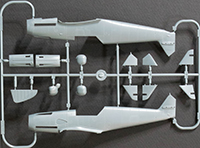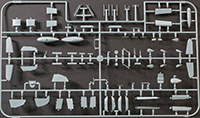
Eduard 1/48 Bf 109F-4 Kit First Look
By Michael Benolkin
| Date of Review | November 2016 | Manufacturer | Eduard |
|---|---|---|---|
| Subject | Bf 109F-4 | Scale | 1/48 |
| Kit Number | 82114 | Primary Media | Styrene, Photo-Etch |
| Pros | Beautiful detailing | Cons | See text |
| Skill Level | Experienced | MSRP (USD) | $49.95 |
First Look
 |
 |
 |
 |
 |
 |
Dr. Willy Messerschmitt was a true aeronautical pioneer whose designs and concepts would transform aircraft designs on drawing boards around the world for generations. In the years between the world wars, Messerschmitt helped to rebuild Germany's armed forces and keep abreast, if not ahead, of the world's transformation from biplane to monoplane aircraft.
The initial prototype of the Bf 109 first flew in 1935, and incorporated many of the transformational innovations being applied elsewhere in the world, along with a few innovations of their own. Powered by the Rolls Royce Kestrel V12 engine, the aircraft used a liquid-cooled engine to reduce the frontal area of the nose and improve the pilot's forward visibility. The wing was a low-wing monoplane design that housed a narrow-track retractable landing gear and used spring-loaded leading edge slats and manually activated trailing edge flaps for lift augmentation at low airspeeds. In other words, the wing design allowed for fast airspeeds while retaining relatively low airspeeds for take-off and landing. The pilot sat in a fully enclosed cockpit. Only the horizontal stabilizer retained external bracing of the biplane era and would do so through most of its production versions.
The Bf 109F was arguably the best handling of the 109 series. The F-series introduced the strut-less tailplanes, a more streamlined nose, and elliptical wingtips. Wing armament had been eliminated in the new wing which left two over-engine machine guns and a single cannon firing through the spinner as the weapons fit for 'Friedrich':
- F-1 was armed with a MG FF 20mm cannon and two 7.92mm machine guns
- F-2 was armed with a MG 151 15mm cannon and two 7.92mm machine guns
- F-3 had the same weapons as the F-2 and more engine power
- F-4 was armed with the improved MG 151/20 20mm cannon and two 7.92 machine guns
- F-4/R1 had two additional underwing 20mm cannons at the sacrifice of performance
Eduard has followed their re-engineered 'Gustav' series with this first example in the 'Friedrich family'. As usual, the kit is molded in gray styrene and presented on four parts trees plus one tree of clear parts. The kit also includes a set of color-printed photo-etched parts for the cockpit plus an additional fret of photo-etched details, and a set of yellow-tape masks for the canopies and wheels. Among the kit's features and options:
- Nicely detailed cockpit
- Color photo-etch instrument panel
- Color photo-etch pilot restraints
- Fuel line w/sight glass molded in clear
- Choice of armored or unarmored windscreen glass
- Positionable canopy
- Choice of headrest armor
- Choice of starboard fuselage gun bulges
- Positionable rudder
- Positionable elevators
- Positionable ailerons
- Positionable leading edge slats
- Positionable flaps
- Positionable radiator flaps
- Nicely represented 'booted' main wheel wells
External stores included for this version:
- Optional centerline bomb and rack
This kit provides markings for five examples:
- Bf 109F-4, W.Nr. 7183, III./JG 2, St.Pol AB, France, 1941, as flown by Hptm Hans 'Assi' Hahn
- Bf 109F-4, W.Nr. unknown, 6./JG 5, Yellow 10, Petsamo AB, Finland, 1942, as flown by Uffz Hans Doebrich
- Bf 109F-4, W.Nr. 7243, Stab/JG 54, Staraya AB, Russia, 1941, as flown by Oblt Otto Kath
- Bf 109F-4, W.Nr. 8693, 3./JG 27, Yellow 14, North Africa, 1942, as flown by Lt Hans-Joachim Marseille
- Bf 109F-4, W.Nr. 7629, 10.(Jabo)/JG 2, Blue 1, France, 1942, as flown by Oblt Frank Liesndahl
- Bf 109F-4, W.Nr. 13325, 9./JG 3, Yellow 7, Shchigry AB, Russia, 1942, as flown by Oblt Viktor Bauer
The decals are provided on two sheets and provides the distinctive unit and airframe markings as well as very thorough set of maintenance stenciling for the airframe. Eduard made a point about how their updated decal process produces decals as good in quality as Cartograf and one advantage Cartograf has is the ability to print very fine and legible stencils. Looking at these two sheets printed by Eduard, if they aren't as sharp as Cartograf, they're really darned close.
As a general scale modeler, I am impressed with this release and think you'll enjoy tackling one of these yourself.
My sincere thanks to Eduard for this review sample!







